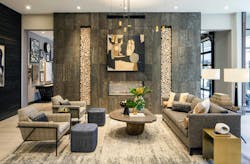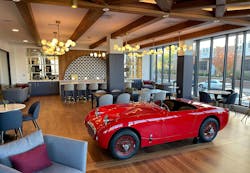If a residential building is the main ingredient of a dish, ornamentation is the seasoning. If there’s too much or too little seasoning, or if it’s just not right, then people won’t want to eat the dish—or spend time in the space.
Mary Cook Associates (MCA), a Chicago-based commercial interior design firm, shares these and other insights about ornamentation in the recently released white paper “Mastering the Art of Embellishment.” It’s the last installment in MCA’s series on its seven fundamentals of design.
MCA defines ornamentation as any “detail that serves no other purpose than to make something more interesting, arresting, or beautiful to us.” That can include artwork, mirrors, tapestries, books, pottery, and sculpture.
Mary Cook, MCA founder and president, recently elaborated on the following tips from the report:
The Who and the Where
Ornamentation begins with an understanding of who and where—who will live in the building and where it is.
Cook’s advice: Consider the inhabitants and what they value, as well as the cultural and historical resonances of the surrounding neighborhood and community. Choose ornamentation that has significance and relevance for the people who will occupy the space.
“Our approach is always to understand clearly who we design for and where they live,” she says.
Who …
When designing the Dey & Bergen apartment building in Harrison, N.J., MCA considered the building’s future occupants—professionals commuting to Manhattan. So MCA drew on a midcentury New York aesthetic for the ornamentation, including the artwork and textiles. “It’s kind of a Mad Men inspiration,” Cook says.
MCA also wanted the building’s speakeasy lounge to feature a centerpiece element that would “create tremendous buzz,” Cook says. She decided that element should be a car—specifically, a vintage 1964 Austin-Healey Bugeye Sprite. The convertible became an Instagram hit. “Everyone takes their picture in the car,” Cook says.
… And Where
For the Notion apartment building in Decatur, Ga., MCA considered the neighborhood’s antique, book, and coffee shops. To create a space that jibes with that vibe, MCA designed lounge and coworking spaces featuring coffee stations and midcentury pieces like cameras and turntables.
For a large impact wall, MCA collaborated with Indiewalls to find local artists who created a wall mural made of book spines. The spines form the image of a bird—to suggest freedom of thought and speech, Cook says. “Everyone was blown away by it.”
It’s About a Visceral Feeling
How do you know if your ornamentation hits the mark? How do you know when you strike the right balance—avoiding both too little ornamentation, which can leave a space feeling cold and uninviting, and too much, which can feel like clutter?
You feel it, Cook says. Ornamentation isn’t about function, it’s about a visceral impact. Attend to the feeling your space creates.
“Some people claim they’re indifferent to accessories and art, but then they find themselves lingering longer in a space. It’s a visceral feeling,” Cook explains. “When you put too many things together or they look clumsy and awkward or they’re too large or too small, people might not be able to articulate what’s wrong, but they’re not drawn to that space and they go to another area.”
It’s Also About Measurable Impact
Effective ornamentation isn’t just about gut instinct. MCA tracks its designs’ measurable impact on the bottom line—what the firm calls the ROE (return on environment).
“We create interiors that help builders and developers sell more homes or add value. We sell faster and at higher prices. We do that by understanding who and where—who we’re designing for and where we are—and then composing just the right number of pieces at the right scale,” Cook says. “It’s part art and part science.”
In addition, she notes, residents want to stay longer in well-designed spaces, so they form lasting relationships and communities.
Cook recalls a builder who had completed two similar residential communities with two model homes. MCA designed one model that became that community’s best-selling unit. The model that MCA didn’t design? “The builder said they couldn’t give that house away,” Cook says.


